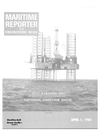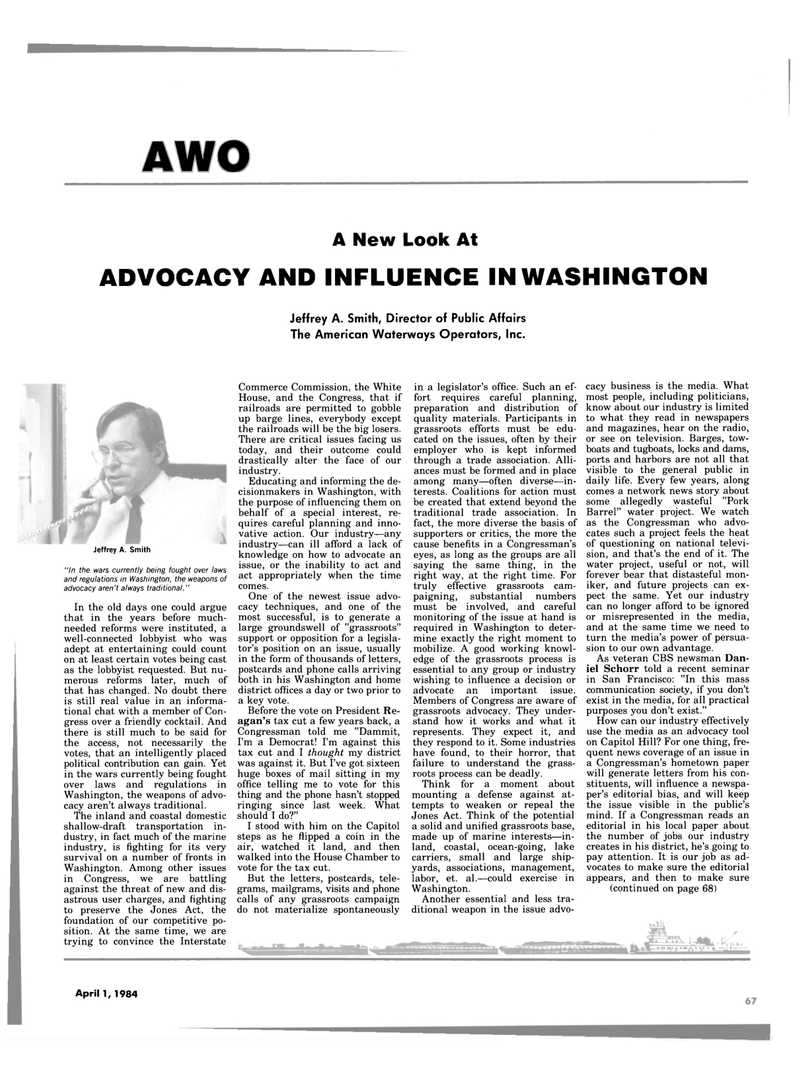
Page 63: of Maritime Reporter Magazine (April 1984)
Read this page in Pdf, Flash or Html5 edition of April 1984 Maritime Reporter Magazine
AWO
A New Look At
ADVOCACY AND INFLUENCE IN WASHINGTON
Jeffrey A. Smith, Director of Public Affairs
The American Waterways Operators, Inc.
Jeffrey A. Smith "In the wars currently being fought over laws and regulations in Washington, the weapons of advocacy aren't always traditional."
In the old days one could argue that in the years before much- needed reforms were instituted, a well-connected lobbyist who was adept at entertaining could count on at least certain votes being cast as the lobbyist requested. But nu- merous reforms later, much of that has changed. No doubt there is still real value in an informa- tional chat with a member of Con- gress over a friendly cocktail. And there is still much to be said for the access, not necessarily the votes, that an intelligently placed political contribution can gain. Yet in the wars currently being fought over laws and regulations in
Washington, the weapons of advo- cacy aren't always traditional.
The inland and coastal domestic shallow-draft transportation in- dustry, in fact much of the marine industry, is fighting for its very survival on a number of fronts in
Washington. Among other issues in Congress, we are battling against the threat of new and dis- astrous user charges, and fighting to preserve the Jones Act, the foundation of our competitive po- sition. At the same time, we are trying to convince the Interstate
Commerce Commission, the White
House, and the Congress, that if railroads are permitted to gobble up barge lines, everybody except the railroads will be the big losers.
There are critical issues facing us today, and their outcome could drastically alter the face of our industry.
Educating and informing the de- cisionmakers in Washington, with the purpose of influencing them on behalf of a special interest, re- quires careful planning and inno- vative action. Our industry—any industry—can ill afford a lack of knowledge on how to advocate an issue, or the inability to act and act appropriately when the time comes.
One of the newest issue advo- cacy techniques, and one of the most successful, is to generate a large groundswell of "grassroots" support or opposition for a legisla- tor's position on an issue, usually in the form of thousands of letters, postcards and phone calls arriving both in his Washington and home district offices a day or two prior to a key vote.
Before the vote on President Re- agan's tax cut a few years back, a
Congressman told me "Dammit,
I'm a Democrat! I'm against this tax cut and I thought my district was against it. But I've got sixteen huge boxes of mail sitting in my office telling me to vote for this thing and the phone hasn't stopped ringing since last week. What should I do?"
I stood with him on the Capitol steps as he flipped a coin in the air, watched it land, and then walked into the House Chamber to vote for the tax cut.
But the letters, postcards, tele- grams, mailgrams, visits and phone calls of any grassroots campaign do not materialize spontaneously in a legislator's office. Such an ef- fort requires careful planning, preparation and distribution of quality materials. Participants in grassroots efforts must be edu- cated on the issues, often by their employer who is kept informed through a trade association. Alli- ances must be formed and in place among many—often diverse—in- terests. Coalitions for action must be created that extend beyond the traditional trade association. In fact, the more diverse the basis of supporters or critics, the more the cause benefits in a Congressman's eyes, as long as the groups are all saying the same thing, in the right way, at the right time. For truly effective grassroots cam- paigning, substantial numbers must be involved, and careful monitoring of the issue at hand is required in Washington to deter- mine exactly the right moment to mobilize. A good working knowl- edge of the grassroots process is essential to any group or industry wishing to influence a decision or advocate an important issue.
Members of Congress are aware of grassroots advocacy. They under- stand how it works and what it represents. They expect it, and they respond to it. Some industries have found, to their horror, that failure to understand the grass- roots process can be deadly.
Think for a moment about mounting a defense against at- tempts to weaken or repeal the
Jones Act. Think of the potential a solid and unified grassroots base, made up of marine interests—in- land, coastal, ocean-going, lake carriers, small and large ship- yards, associations, management, labor, et. al.—could exercise in
Washington.
Another essential and less tra- ditional weapon in the issue advo- cacy business is the media. What most people, including politicians, know about our industry is limited to what they read in newspapers and magazines, hear on the radio, or see on television. Barges, tow- boats and tugboats, locks and dams, ports and harbors are not all that visible to the general public in daily life. Every few years, along comes a network news story about some allegedly wasteful "Pork
Barrel" water project. We watch as the Congressman who advo- cates such a project feels the heat of questioning on national televi- sion, and that's the end of it. The water project, useful or not, will forever bear that distasteful mon- iker, and future projects can ex- pect the same. Yet our industry can no longer afford to be ignored or misrepresented in the media, and at the same time we need to turn the media's power of persua- sion to our own advantage.
As veteran CBS newsman Dan- iel Schorr told a recent seminar in San Francisco: "In this mass communication society, if you don't exist in the media, for all practical purposes you don't exist."
How can our industry effectively use the media as an advocacy tool on Capitol Hill? For one thing, fre- quent news coverage of an issue in a Congressman's hometown paper will generate letters from his con- stituents, will influence a newspa- per's editorial bias, and will keep the issue visible in the public's mind. If a Congressman reads an editorial in his local paper about the number of jobs our industry creates in his district, he's going to pay attention. It is our job as ad- vocates to make sure the editorial appears, and then to make sure (continued on page 68)
April 1, 1984 65

 62
62

 64
64
